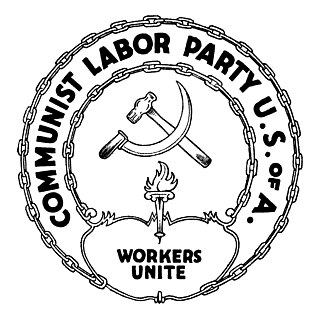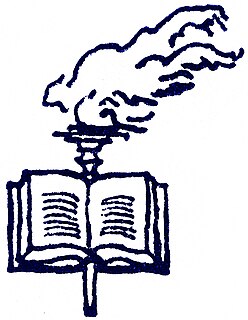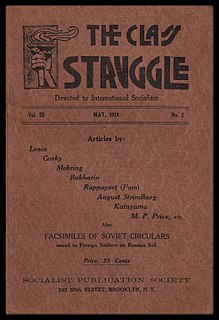Organizational history
Early years
Following the failure of the Russian Revolution of 1905, a large number of members and active supporters of the Russian Socialist Revolutionary Party and the Bolshevik and Menshevik wings of the Russian Social Democratic Labor Party elected to follow the course of political emigration to America. [1] These politically minded individuals sought to form a political organization within the so-called "Russian colony" in America, with the initial intent of assisting the revolutionary movement in Russia which was working to overthrow the Tsarist regime of Nikolai Romanov. [1] To this end, various branches of Russian-speaking revolutionary socialists began to be formed in those areas of the country with a significant émigré population. The national organization uniting these local groups was known as the Russian Socialist Federation.
The Russian Socialist Federation maintained its own daily newspaper called Novyi Mir (New World), published in New York. [2] This paper was for a time edited by Nikolai Bukharin, later one of the top leaders of Soviet Russia after the Russian Revolution of 1917. [1] Contributors included Leon Trotsky, who wrote for the paper during his brief interlude in New York City from his arrival in the city in the first days of 1917 [3] until his departure on March 27, 1917. [4] The paper's office was located "in a dingy hole at the rear of the cellar" at 77 St. Mark's Place. [3]
Admission to the Socialist Party of America
The "Federation of Russian Branches" was admitted to the Socialist Party of America in May 1915, with party records indicating that the group had an average of 113 dues-paying members in its first year of affiliation. [5]
Impact of the Russian Revolution
The Russian Revolution of 1917, marking the downfall of the tsarist state and its replacement by a revolutionary Marxist government headed by V.I. Lenin exerted an enormous impact on the émigré community in the United States. A political party which touted just 11,000 members in May 1917 had effectively seized control of a great state, demonstrating to many adherents of socialism that a slow process of building a political organization and winning the support of a majority of the population was not strictly necessary. [6]
In the words of historian Theodore Draper:
"The supreme lesson seemed to be that a small party could seize power if only it had enough revolutionary zeal and purity of doctrine. No revolutionary group could guarantee numbers, but zeal and doctrine could be had for the asking. Such was the infinitely optimistic horizon that the Bolshevik revolution appeared to open up." [7]
Only a few months before the leader of the Red Army himself, Leon Trotsky, had been among the Russian émigré community as a journalist in New York City, writing for the newspaper of the Russian Federation. Now he sat next to Lenin at the head of a dramatic revolution of world-historical importance. The speed and proximity of the transformation was shocking and its impact electrifying. [8]
Efforts to construct a unified revolutionary organization proceeded apace. The Marxists of the Russian Socialist Federation attempted to join with its populist and anarchist comrades in a unified organization through a convention of the United Russian parties held in New York City from February 1 to 4, 1918. [9] Socialist Gregory Weinstein — editor of Novyi Mir and later a founding member of the Communist Labor Party of America — was elected chairman of the session. [9] The gathering sent a cable to the Council of People's Commissars in Moscow sending greetings to revolutionary Russia and indicating that they were "ready to organize Revolutionary Legions for Russia." [9]
The Russian Federation was also instrumental in the formation of the American Bolshevik Bureau of Information early in 1918, uniting with four other Russian groups as well as the English-speaking Socialist Propaganda League. [10] Nicholas Hourwich represented the Russian Federation on this body, being joined by Soviet Russian representative Ludwig Martens as the delegate of the "New York Section of Russian Bolsheviki" and S.J. Rutgers of the Socialist Propaganda League. [10] The Bureau, which served as a forerunner of the official Russian Soviet Government Bureau, was headed by Louis C. Fraina. [10]
The Russian Socialist Federation held its 4th National Convention in New York City from September 28 through October 2, 1918. The gathering elected future Communist Party of America stalwarts Oscar Tyverovsky was elected Secretary of the Russian Federation and Alexander Stoklitsky as "Translator-Secretary," a functionary of the national Socialist Party of America with an office at party headquarters in Chicago. [11]
The gathering also determined to convene a gathering of the various language groups associated with the former Russian empire — Lithuanian, Latvian, Ukrainian, Jewish, and Polish, in addition to the Russian — in order "to effect unity of action of all Russian Federations and organizations by one united center." [12] This unification of various language federations under the aegis of the Russian Socialist Federation was soon to have repercussions, accelerating development of a split of the Socialist Party between its revolutionary Left Wing and the electorally oriented individuals who had long dominated the party apparatus.
The split of 1919
During the first two months of 1919 a concrete Left Wing Section established itself within the ranks of the Socialist Party of America (SPA). Inspired by the November 1917 Bolshevik Revolution in Russia and disgruntled over the largely ineffectual Socialist Party electoral campaign of 1918, this group began to unite around the February 1919 elections of members of the 15 member National Executive Committee which governed the SPA.
A programmatic document called the Left Wing Manifesto, written by a committee in New York and thoroughly revised by Louis Fraina, began to be circulated among locals and branches of the Socialist Party for their approval. A new weekly publication called The Revolutionary Age , edited in Boston by Louis Fraina, was established to advance the Left Wing cause. In April 1919, the Left Wing Section of the Socialist Party of Local New York established yet another weekly newspaper called The New York Communist. [13]
The foreign language federations of the Socialist Labor Party, led in the first place by the Russian Federation, were among the leaders of this drive to "capture" the Socialist Party for revolutionary socialism. Language branches of the unified "Russian Federations" often delivered their votes en bloc for slates of candidates in each of the Socialist Party's five regional electoral districts, allowing the candidates approved by the Left Wing to garner sufficient votes for election to a majority of the 15 seats on the NEC.
The outgoing National Executive Committee, dominated by older and more cautious adherents of the Socialist Party's traditional electoral approach to the winning of state power, were not about to surrender without a fight, however. A cry of election fraud was raised, culminating with the June 1919 suspension of seven of the party's language federations and the annulment of the 1919 election pending the decision of an August 1919 Emergency National Convention of the party.

The Communist Labor Party of America (CLPA) was one of the organizational predecessors of the Communist Party USA.

The Proletarian Party of America (PPA) was a small communist political party in the United States, originating in 1920 and terminated in 1971. Originally an offshoot of the Communist Party of America, the group maintained an independent existence for over five decades. It is best remembered for carrying forward Charles H. Kerr & Co., the oldest publisher of Marxist books in America.

Charles Emil Ruthenberg was an American Marxist politician and a founder and head of the Communist Party USA (CPUSA).

The Socialist Propaganda League of America (SPLA) was established in 1915, apparently by C.W. Fitzgerald of Beverly, Massachusetts. The group was a membership organization established within the ranks of the Socialist Party of America and is best remembered as direct lineal antecedent of the Left Wing Section of the Socialist Party and its governing National Council — the forerunner of the American Communist movement.

Alfred Wagenknecht was an American Marxist activist and political functionary. He is best remembered for having played a critical role in the establishment of the American Communist Party in 1919 as a leader of the Left Wing Section of the Socialist Party. Wagenknecht served as Executive Secretary of the Communist Labor Party of America and the United Communist Party of America in 1919 and 1920, respectively.

The Russian Soviet Government Bureau (1919-1921), sometimes known as the "Soviet Bureau," was an unofficial diplomatic organization established by the Russian Soviet Federative Socialist Republic in the United States during the Russian Civil War. The Soviet Bureau primarily functioned as a trade and information agency of the Soviet government. Suspected of engaging in political subversion, the Soviet Bureau was raided by law enforcement authorities at the behest of the Lusk Committee of the New York State legislature in 1919. The Bureau was terminated early in 1921.

The Left Wing Section of the Socialist Party was an organized faction within the Socialist Party of America in 1919 which served as the core of the dual communist parties which emerged in the fall of that year—the Communist Party of America and the Communist Labor Party of America.
The 1919 Emergency National Convention of the Socialist Party of America was held in Chicago from August 30 to September 5, 1919. It was a seminal gathering in the history of American radicalism, marked by the bolting of the party's organized left wing to establish the Communist Labor Party of America.

Herbert Moore "Harry" Wicks (1889–1956), best known as "Harry M. Wicks," was an American radical journalist and politician who was a founding member of the Communist Party of America. He was a plenipotentiary representative of the Communist International to Australia in 1930-31 and there directed the reorganization of the structure and leadership of the Communist Party of Australia.

Ludwig Erwin Alfred "Dutch" Katterfeld (1881–1974) was an American socialist politician, a founding member of the Communist Labor Party of America, a Comintern functionary, and a magazine editor.
The Finnish Socialist Federation was a language federation of the Socialist Party of America which united Finnish language-speaking immigrants in the United States in a national organization designed to conduct propaganda and education for socialism among their community.

Louis C. Fraina was a founding member of the American Communist Party in 1919. After running afoul of the Communist International in 1921 over the alleged misappropriation of funds, Fraina left the organized radical movement, emerging in 1926 as a left wing public intellectual by the name of Lewis Corey. During the McCarthy era, deportation proceedings were initiated against Fraina-Corey. After a protracted legal battle, Corey died of a cerebral hemorrhage before the action against him was formally abandoned.
The Left Wing Manifesto is the name rather confusingly bestowed upon two distinct programmatic documents of the Left Wing Section of the Socialist Party during the factional war in the Socialist Party of America of 1919.

The Jewish Socialist Federation (JSF) was a secular Jewish Yiddish-oriented organization founded in 1912 which acted as a language federation in the Socialist Party of America (SPA). Many of the founding members of the JSF had previously been members of the Bund in Eastern Europe and sought to bring Bundist politics to the socialist movement in the USA.

The Class Struggle was a bi-monthly Marxist theoretical magazine published in New York City by the Socialist Publication Society. The SPS also published a series of pamphlets, mostly reprints from the magazine during the short period of its existence. Among the initial editors of the publication were Ludwig Lore, Marxist theoreticians Louis B. Boudin and Louis C. Fraina, the former of whom left the publication in 1918. In the third and final year of the periodical, The Class Struggle emerged as one of the primary English-language voices of the left wing factions within the American Socialist Party and its final issue was published in 1919 by the nascent Communist Labor Party of America.

The Union of Russian Workers in the United States and Canada, commonly known as the "Union of Russian Workers" was an anarchist political association of Russian emigrants in the United States. The group was established shortly after the failure of the Russian Revolution of 1905 and was essentially annihilated in America by the 1919 Red Scare in which it was targeted by the Bureau of Investigation of the U.S. Department of Justice. Thousands of the group's adherents were arrested and hundreds deported in 1919 and 1920; still more voluntarily returned to Soviet Russia. During its brief existence the organization, which was only loosely affiliated with the Industrial Workers of the World, published numerous books and pamphlets in Russian by anarchist writers, operated reading rooms and conducted courses to teach newly arrived Russians English, and fulfilled a social function for emigrants half a world from home.

Dennis E. Batt was an American political journalist and trade union activist. Best remembered as the first editor of The Communist, the official organ of the Communist Party of America and leading member of the Proletarian Party of America, in later years Batt's political views became increasingly conservative and he ended his life as a mainstream functionary in the union movement.

The 1922 Bridgman Convention was a secret conclave of the underground Communist Party of America (CPA) held in August 1922 near the small town of Bridgman, Michigan, about 90 miles (140 km) outside of the city of Chicago on the banks of Lake Michigan. The convention, called by the CPA as its annual gathering for the election of officers and making of internal decisions, was attended by a delegate who was secretly an employee of the Bureau of Investigation, who informed his superiors of the date and general location of the gathering. The convention was raided by local and federal law enforcement authorities on August 22, 1922, and a number of participants and a large quantity of documents seized in an operation which garnered national headlines. Two 1923 test trials of the Michigan criminal syndicalism law resulted from the arrests, with trade union leader William Z. Foster freed by a "hung jury," while Communist Party leader C. E. Ruthenberg was convicted. Ruthenberg ultimately died of peritonitis in 1927, just after his appeals were exhausted and just before sentence was enforced. No additional trials associated with the 1922 Bridgman raid were conducted.
John J. "Johnny" Ballam was an American Marxist political activist and trade union organizer. He is best remembered as a founding member and one of the pioneer leaders of the Communist Party of America and as a leader of the Trade Union Unity League in the textile industry during the 1930s.

The Revolutionary Age was an American radical newspaper edited by Louis C. Fraina and published from November 1918 until August 1919. Originally the publication of Local Boston, Socialist Party, the paper evolved into the de facto national organ of the Left Wing Section of the Socialist Party which battled for control of the Socialist Party throughout the spring and summer of 1919. With the establishment of the Left Wing National Council in June 1919, the paper was moved from Boston to New York City gained status as the official voice of the nascent American communist movement. The publication was terminated in August 1919, replaced by the official organ of the new Communist Party of America, a weekly newspaper known as The Communist.















